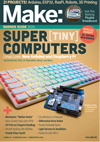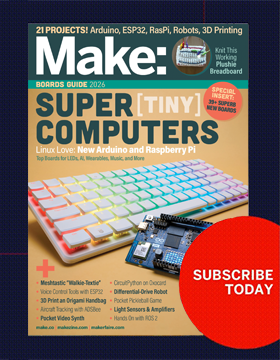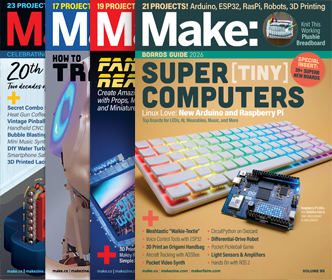
Magnetic Maze
WHAT WILL YOU MAKE?
A fun custom maze game you can program yourself with Makey Makey!
WHAT WILL YOU LEARN?
You will learn to make a simple soft circuit. You will learn to use a Makey Makey and Scratch to control your game.
STEPS
STEP 1
1. Plan out your maze.
STEP 2
2. Test your LEDs.
STEP 3
3. Start with a simple maze.
STEP 4
4. Now make a more complex maze!
STEP 5
5. Set up your Scratch Sketch.
STEP 6
6. Attach the MaKey MaKey.
WHAT'S HAPPENING HERE?
Makey Makey is an invention kit designed to connect everyday objects to computer keys. Using a circuit board, alligator clips, and a USB cable, the toy uses closed loop electrical signals to send the computer either a keyboard stroke or mouse click signal. This function allows the Makey Makey to work with any computer program or webpage that accepts keyboard or mouse click.
Materials:
- Laptop with internet access
- Card table or other thin table
- MaKey MaKey
- Alligator clip wires
- 2 magnets
- Modeling clay
- LEDs
- 9V battery
- Paper
- Pen/Pencil
See More Projects in these topics:
Games Microcontrollers ProgrammingSee More Projects from these themes:
The Depot (Airport/Space Station/ Racetrack)Maker Camp
Please Note
Your safety is your own responsibility, including proper use of equipment and safety gear, and determining whether you have adequate skill and experience. Power tools, electricity, and other resources used for these projects are dangerous, unless used properly and with adequate precautions, including safety gear and adult supervision. Some illustrative photos do not depict safety precautions or equipment, in order to show the project steps more clearly. Use of the instructions and suggestions found in Maker Camp is at your own risk. Make Community, LLC, disclaims all responsibility for any resulting damage, injury, or expense.
Maker Camp Project Standards
Based on NGSS (Next Generation Science Standards)
K–12 Computer Science Framework
The K–12 Computer Science Framework is designed to guide computer science from a subject for the fortunate few to an opportunity for all. The guiding practices include:- Fostering an Inclusive Computing Culture
- Collaborating Around Computing
- Recognizing and Defining Computational Problems
- Developing and Using Abstractions
- Creating Computational Artifacts
- Testing and Refining Computational Artifacts
- Communicating About Computing
K–12 Computer Science Framework
The K–12 Computer Science Framework is designed to guide computer science from a subject for the fortunate few to an opportunity for all. The guiding practices include:- Fostering an Inclusive Computing Culture
- Collaborating Around Computing
- Recognizing and Defining Computational Problems
- Developing and Using Abstractions
- Creating Computational Artifacts
- Testing and Refining Computational Artifacts
- Communicating About Computing
NGSS MS.Engineering Design
The Next Generation Science Standards (NGSS) are K–12 science content standards.- MS-ETS1-1. Define the criteria and constraints of a design problem with sufficient precision to ensure a successful solution, taking into account relevant scientific principles and potential impacts on people and the natural environment that may limit possible solutions.
- MS-ETS1-2. Evaluate competing design solutions using a systematic process to determine how well they meet the criteria and constraints of the problem.
- MS-ETS1-3. Analyze data from tests to determine similarities and differences among several design solutions to identify the best characteristics of each that can be combined into a new solution to better meet the criteria for success.
- MS-ETS1-4. Develop a model to generate data for iterative testing and modification of a proposed object, tool, or process such that an optimal design can be achieved.
NGSS HS.Engineering Design
The Next Generation Science Standards (NGSS) are K–12 science content standards.- HS-ETS1-1. Analyze a major global challenge to specify qualitative and quantitative criteria and constraints for solutions that account for societal needs and wants.
- HS-ETS1-2. Design a solution to a complex real-world problem by breaking it down into smaller, more manageable problems that can be solved through engineering.
- HS-ETS1-3. Evaluate a solution to a complex real-world problem based on prioritized criteria and trade-offs that account for a range of constraints, including cost, safety, reliability, and aesthetics as well as possible social, cultural, and environmental impacts.
- HS-ETS1-4. Use a computer simulation to model the impact of proposed solutions to a complex real-world problem with numerous criteria and constraints on interactions within and between systems relevant to the problem.
ALL DONE? SHARE IT!
Share pictures and videos of your cool build! Be sure to use #maketogether or #makercamp
POST YOUR PROJECTS


